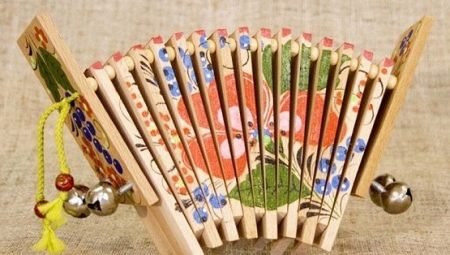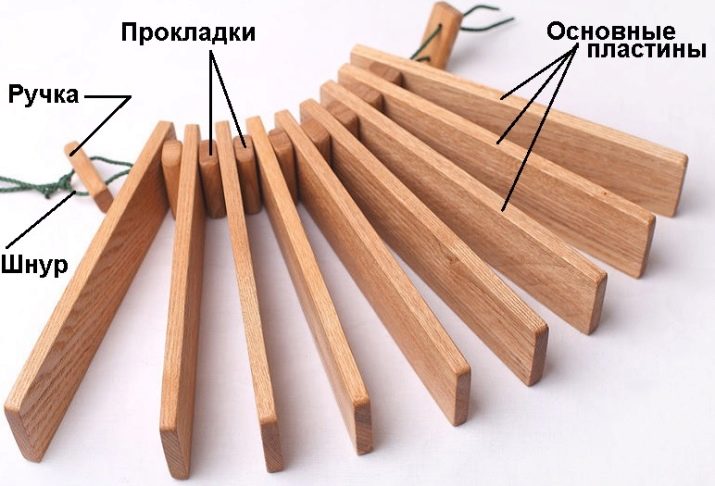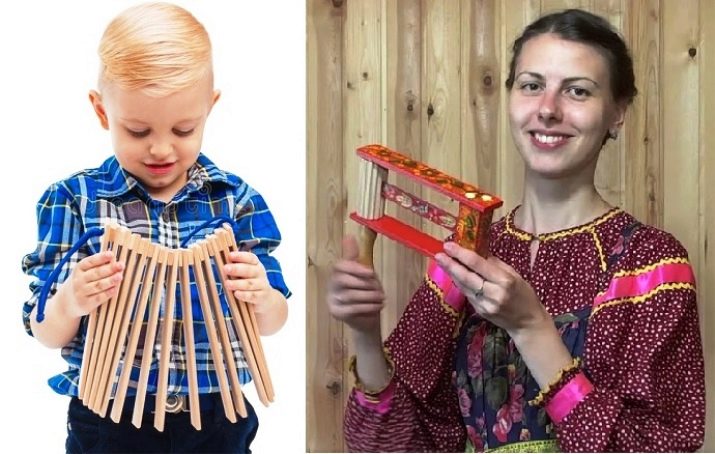Ratchet: history and description of a musical instrument

Among the wooden folk musical instruments of Russia, rattles have been known for a long time. They belong to percussion instruments, since they replace claps of hands, which is also often practiced in group performances of songs, ritual couplets and dances during various folk holidays, festivities and weddings.

History of appearance
It is not known for certain where, by whom and when the ratchets were invented. There is only some archaeological evidence suggesting the appearance of lamellar noise musical instruments near Novgorod no later than the 12th century.... They were also used in other areas of the European part of Russia. There are still craftsmen in the villages of the Tula, Kaluga, Novgorod, Kursk and Leningrad regions, engaged in the manufacture of ratchets of various designs.
The reasons for their appearance in the Middle Ages, most likely, were such factors:
- the usual desire to diversify the meager set of musical accompaniment among the villagers with a home-made and easy-to-make percussion instrument;
- clapping your hands at street festive events in frosty winters is very difficult (and you can use mittens to use a ratchet).

Any of the above reasons, or both at once, could have inspired woodworkers from different places in medieval Russia to invent a ratchet. This happened, of course, not at the same time, and thanks not to one person, but the fact remains: the instrument appeared, was used in the past, is still used in folk musical groups that support Russian ancient traditions and culture.
Varieties
The wooden percussion musical instrument ratchet has another name - crackling.
By design, ratchets are divided into 2 main types:
- lamellar;
- circular.

But even among these groups there is a division into varieties according to various criteria. For example, lamellar in appearance are called fan-shaped, flat, Kursk, and cranked. All of them represent similar models (fan-shaped from wooden plates), but differ either in the shapes of their plates (rounded at the free ends and completely square, of the same size and having different lengths), or in the execution of plates and spacers (single and separate).
Circular ratchets are not available in many varieties.:
- mono-reed;
- consisting of several reeds;
- single-lane (single-frame);
- two-lane.
They may also differ in the dimensions of the frame, the execution of the mechanism for rotating the frame on the handle, the material of the tongues and the design of the toothed insert.

Description
Plate models of ratchets are made from a set of dry and well-finished wooden planks length from 13 to 18 cm and width from 5 to 7 cm. The thickness of the planks is 5-6 mm. A set of ratchet plates can consist of any number of them (from 12 to 20 pcs.). The best material for making plates is oak wood.... In the absence of this material, maple or walnut wood (that is, hardwoods) is used.
Oak rattles produce the clearest and loudest sound than those made from any other plant.
A spacer is installed between each plate - the same plate, the length of which is no more than 1/3 of the length of the main one. The thickness of the gasket is 3 mm.
At one end of the main plates and their gaskets, 2 identical holes are drilled both at the location on the planes and in diameter (3 mm). After that, the plates and gaskets are alternately strung through the holes on a rope, cord or thick fishing line, which, at the end of the installation of the strips, are fixed with knots or on the handles. Often, lamellar ratchets are supplemented with several bells and decorated with ribbons to draw the listener's attention to this musical instrument..

Circular ratchets consist of a body and a handle... The body is a rectangular wooden frame with dimensions 20x10, 20x5, 30x10. The handle is inserted into the body at one end across its long side. On the axis of the handle, inside the frame, there is a toothed wheel (insert), which is a wooden gear-type cylinder.
A groove is made in the short side of the frame opposite from the gear, into which an elastic wooden or steel plate, called a "tongue", is inserted. The tongue reaches with its free end to the teeth of the insert, which it snaps into when the frame rotates around... The sound of such a ratchet is reminiscent of continuous shooting from a children's machine.
Circular instruments are available with double frames in one body or with multiple tongues in one frame.

How to play?
Even children can play the circular ratchet without any problems: you just need to take the tool by the handle and rotate the frame around the axis. Children's toys made in the likeness of a rattle are very popular.
Another option, very interesting and useful in terms of development for children, is fan. With him, a lot of things can be developed in a child (coordination, rhythm, attention).
The lamellar instrument is held in front of you with your hands on both sides at chest level. When playing, a fan of records is given the opportunity to unfold, and then return to its original state with a bang. By the actions of both hands: shaking hands alternately, raising or lowering their hands, turning the instrument, the musicians create the most incredible rhythmic patterns.









